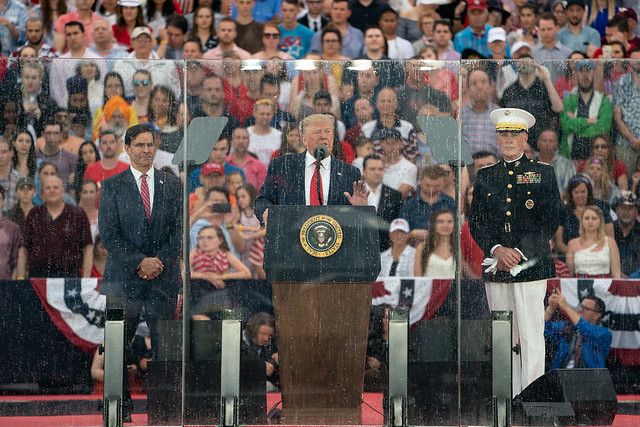
President Trump just honored the United States' crowning spaceflight achievement, and stressed that the nation will make an even bigger leap in the coming years.
During his Fourth of July speech at the Lincoln Memorial in Washington, D.C., yesterday, the president cited the Apollo 11 moon landing as an example of American ingenuity, spirit and potential.
"For Americans, nothing is impossible," Trump said. "Exactly 50 years ago this month, the world watched in awe as Apollo 11 astronauts launched into space with a wake of fire and nerves of steel, and planted our great American flag on the face of the moon."
Related: Apollo 11 at 50: A Complete Guide to the Historic Moon Landing Mission
He then addressed Apollo program flight director Gene Kranz, who was in attendance at yesterday's event.
"Gene, I want you to know that we're going to be back on the moon very soon, and, someday soon, we will plant the American flag on Mars," the president said.
You can watch Trump's full speech here. The Apollo 11 comments begin just after the 9-minute mark.
Get the Space.com Newsletter
Breaking space news, the latest updates on rocket launches, skywatching events and more!
In December 2017, Trump directed NASA to send people back to the lunar surface and establish a sustainable long-term presence on and around Earth's nearest neighbor. These goals are not ends in themselves; the ambitious moon program, which NASA recently named Artemis, will help the agency prepare for a journey to the ultimate human-spaceflight destination: Mars.
The original target date for the upcoming lunar landing — the first crewed touchdown since the end of the Apollo program in 1972 — was 2028. But this past March, Vice President Mike Pence instructed NASA to pick up the pace and get it done by 2024.
The 2024 landing will occur near the moon's south pole, where water ice is abundant on the floors of permanently shadowed craters, and will feature at least one female astronaut, NASA officials have said. All 12 people who have set foot on the moon to date are men.
One of Artemis' central pieces is a small, moon-orbiting space station called the Gateway, which NASA plans to start building in the early 2020s. This outpost will serve as a jumping-off point for sorties, both crewed and uncrewed, to the lunar surface.
NASA plans to make all this happen using the Orion crew capsule and the huge Space Launch System (SLS) rocket, both of which are in development. Earlier this week, Orion passed a critical launch abort test, which showed that the capsule is capable of getting astronauts out of harm's way in the event of an emergency during liftoff.
Orion and SLS are scheduled to fly together for the first time next summer on an uncrewed trip around the moon called Artemis 1. The Artemis 2 lunar flyby mission, targeted for 2022, will be the first crewed flight for the duo.
If everything goes smoothly with Artemis, NASA will begin serious preparations for a crewed Mars mission. The agency hopes to put boots on the Red Planet before the end of the 2030s.
- The Apollo Moon Landings: How They Worked (Infographic)
- Can NASA Really Put Astronauts on the Moon in 2024?
- How the Apollo 11 Moon Landing Worked (Infographic)
Mike Wall's book about the search for alien life, "Out There" (Grand Central Publishing, 2018; illustrated by Karl Tate), is out now. Follow him on Twitter @michaeldwall. Follow us on Twitter @Spacedotcom or Facebook.
Join our Space Forums to keep talking space on the latest missions, night sky and more! And if you have a news tip, correction or comment, let us know at: community@space.com.

Michael Wall is a Senior Space Writer with Space.com and joined the team in 2010. He primarily covers exoplanets, spaceflight and military space, but has been known to dabble in the space art beat. His book about the search for alien life, "Out There," was published on Nov. 13, 2018. Before becoming a science writer, Michael worked as a herpetologist and wildlife biologist. He has a Ph.D. in evolutionary biology from the University of Sydney, Australia, a bachelor's degree from the University of Arizona, and a graduate certificate in science writing from the University of California, Santa Cruz. To find out what his latest project is, you can follow Michael on Twitter.









